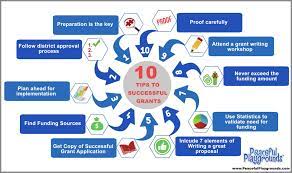Do you need to raise money for your group but don’t know where to begin? Grants might be difficult to come by, but with the appropriate knowledge and a little forethought, you can succeed. As a grant writer, you know that following the appropriate Grant-Writing tips and methods is crucial to your success. Whether you’re a first-time grant writer or have been submitting applications for a long time, the suggestions below can help you increase your chances of being granted. We’ll lead you through all you need to know about writing grants that produce results, from mastering the proposal narrative to comprehending the review process. So, keep reading to find out how you may increase your chances of receiving funding.
Start By Brainstorming and Making a List Of Potential Funding Sources
It’s critical to have a clear grasp of your project and what it will include before you begin writing anything. You may start creating a list of prospective financing sources once you know what your project is about. This list will be useful in two ways: first, it will help you figure out where to look for grant possibilities, and second, it will keep you focused as you limit down your selections. It’s the first step toward putting together a grant-writing plan.
- Understand the Grantor’s Priorities and Interests

When crafting a proposal, it’s critical to know what the grantor is looking for. What are their main concerns? What qualities do they look for in a successful project? Aligning your project’s goals with the grantor’s will increase your chances of receiving funding. Keep in mind that most grantors are looking for initiatives that have a specific goal in mind, such as offering educational opportunities, protecting the environment, or assisting people in need. Make careful to emphasize how your project aligns with the grantor’s goals while preparing your proposal. Also, be sure to clarify how your initiative will help the neighborhood or audience you’re aiming for.
- Use Clear And Concise Language
When drafting your grant, be sure you utilize language that everyone can understand. Avoid employing jargon, acronyms, or abbreviations that are unfamiliar to the typical individual. The purpose of a grant is to offer financial support for a certain cause; if the reader can’t understand what you’re saying, they won’t be able to tell if your project satisfies their requirements. Make sure your explanations are precise and succinct so that your goals are not misunderstood. Use this article to help you understand how to apply for a federal pell grant.
- The Project Narrative
One of the most significant components of your proposal is the project story. This is where you’ll go through the specifics of your project and how it’ll be carried out. Include a full explanation of the activities that will take place, as well as information on what you intend to achieve with your project. Also, offer a timetable for your project so that the grantor can understand how it will progress over time. Next, submit a budget for your project so the grantor can understand how much money you’ll need to finish it.
- Create a Budget and Project Timeline

The next stage is to create a budget and a schedule for the project. This can help you figure out how much money you’ll need and how long it’ll take to finish your job. When determining your budget and timeline, it’s critical to be as realistic as possible, as this information will be utilized by the funding organization to decide whether or not your project is viable. It is the first thing the grantor will see; therefore, it is critical to make a good first impression.
- Include a Cover Letter
The cover letter is your opportunity to tell the grantor about yourself and your proposal. You’ll want to describe why you’re asking for assistance and how the funds will be utilized in this letter. You should also include information about your company and its history, as well as any relevant project management expertise you have. Before sending your cover letter out, double-check it for typos, since they might create the impression that you’re not structured or detail-oriented. Also, rather than writing to a broad organization, address the letter to a specific person, since this will demonstrate that you are interested in building a personal relationship.
- Follow Up After Submitting Your Application
It’s critical to follow up with the grantor once you’ve filed your application. Make sure to express your gratitude for their time and consideration of your application, as well as your enthusiasm for the project. You may also want to incorporate any extra material that was not included in the first application, such as fresh data or project developments. Following up demonstrates your commitment to the cause and enhances the likelihood that your application will be taken seriously.
- Be Professional In Your Approach

It’s critical to keep in mind that you’re seeking money from a company or organization. As a result, your application has to be formal, well-written, and error-free. You should also follow any directions or recommendations that have been given to you. Following the right structure and displaying a high degree of professionalism will demonstrate that you are serious about your request and will boost your chances of receiving funds. In your application, there should be no begging or pleading; simply describe your case and let the facts speak for themselves.
- Know Your Audience
When drafting your grant proposal, keep in mind that you’re writing for a specific audience. The standards, priorities, and preferences of the organization or individual to whom you’re submitting the application will differ. Before you start writing your proposal, do some research and make sure you know what they’re looking for. If you try to fit your idea into their mold, you’ll have a better chance of getting your application accepted. It will assist you in crafting a more focused story and avoiding any potential misunderstanding on the review committee’s side.
Use Data to Support Your Case

It’s critical to back up your statements with statistics when presenting your case for why your project merits financing. Statistics, expert views, and anecdotal evidence are all examples of this. Supporting your arguments with solid proof, in whatever shape it takes, will make your case far more compelling. Furthermore, presenting any previous data from similar initiatives might help to demonstrate that your planned project is likely to succeed.
Conclusion
To summarize, the suggestions for writing a successful grant given above are only a few of the various tactics you may employ to boost your chances. Keep in mind that each funder is unique and has their own set of needs.












